Apple variety Yubilyar
Jubilee is a triploid apple variety with fruits of late summer ripening, bred in 1982 at the All-Russian Research Institute of Breeding of Fruit Crops (814-free pollination) through sowing seeds. In fact, this is a seedling from free pollination of an elite hybrid form 814 (F2, M. floribunda 821 x Golden Delicious). In 1989, the seedling fruited for the first time (that is, in the 8th year from the moment of sowing), and in 1990 it was allocated to the elite. The authorship belongs to E.N. Sedov, Z.M. Serova, G.A. Sedysheva and V.V. Zhdanov. In 1995, the variety was sent to the State test in the Central and Central Black Earth regions of Russia. Also recommended for testing in the Lower Volga region. The Yubilyar apple tree is suitable for cultivation in intensive gardens.
The trees are medium-sized and fast-growing. The crown is round, of medium density. The main branches of a curved shape, with their ends directed downward, are rarely located, when they leave the trunk, they form a close to right angle. The bark of the trunk and main branches with a smooth surface, painted in gray. Fruiting is mixed, but most often fruit formations are tied on simple and complex ringlets.
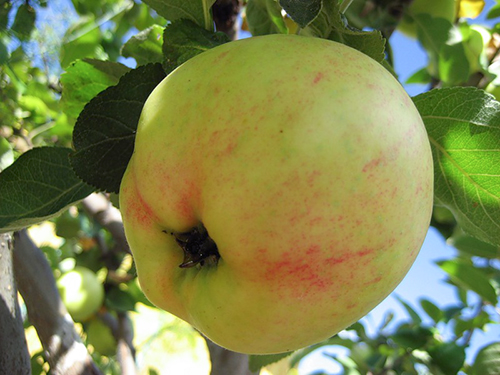
Shoots are medium in thickness, geniculate, in cross section - rounded, fleecy, brown in color. Lentils are of medium size, rarely found on the shoot. The buds are fleecy, compressed, conical in shape. The leaves are green, wide, large in size, rounded, short-pointed, with a helical twisted top and wavy, serrate-crenate edges. The leaf blade is concave, pubescent, with a glossy, wrinkled surface and coarse venation. Petioles are thick, medium in length, non-pubescent, anthocyanin color. Flower buds of medium size, elongated, fleecy.
The fruits of the Yubilyar apple tree usually grow to medium and above-average size (apple weight is 130-140 grams) and have a wide rounded-conical shape, the ribbing is weak. The peel of apples is smooth, with a glossy sheen. At the time of picking, the main color of the fruit is greenish, during the period of consumption it is greenish-yellow. The cover color is expressed on a small part of the fruit through a streaky-speckled crimson blush. The subcutaneous dots are green, of medium size, well expressed and common. The stalks are thin, medium in length, straight, set at an angle. The funnel is medium in depth, narrow, conical, moderately corroded. Open cup of fruit. The saucer is wide, deep, grooved. The heart is large in size, heart-shaped. Seed chambers of a closed type. The sub-cup tube is medium in depth, cauldron-shaped. Seeds are medium in size, conical in shape.

The pulp of apples has a creamy shade, fine-grained consistency, medium-dense, crispy, very juicy, tender, with a good sweet and sour taste (but the variety still does not reach the dessert taste). On a 5-point tasting scale, the appearance of the fruit is estimated at 4.4 points, the taste - at 4.2 points. By chemical composition, the fruits contain: the sum of sugars (10.5%), titratable acids (0.96%), ascorbic acid (17.6 mg / 100 g), P-active substances (453 mg / 100 g). A universal variety (fresh consumption, dried fruits, processing into juices, jelly, compotes, fruit wines, preserves, cider, jams, mousses, jellies, jam).
Under the conditions of Orel, the fruits reach removable maturity in the period from August 25 to September 5 (a little later Melba). The consumer period lasts about 1 month (until the end of September).
The Yubilyar apple tree is not fast-growing, the trees enter the fruiting season from the 8th year after planting. Fruiting is regular.The yield is quite high: in the period from 1991 to 1994, the variety gave an average of 182 c / ha (for comparison: the average yield for the control variety Melba for the same period was only 49 c / ha). With regard to winter hardiness: under the conditions of the Oryol region, it is quite high and, in general, not lower than that of Melba. The variety is endowed with absolute immunity to scab (Vf gene), therefore, even in the years of epiphytoties, fruits and leaves are not affected by the disease.
The variety is self-fertile. For planting trees, breathable, moisture-consuming, fertile, sandy loam and loamy soils are preferred.
This apple tree is appreciated for its high and regular yields, strong immunity to scab, high commercial and consumer qualities of apples with late summer ripening.
Among the disadvantages are low early maturity and self-infertility (pollinating varieties are required).
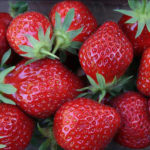
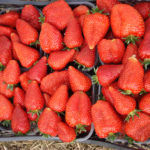
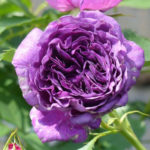
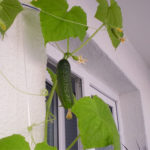
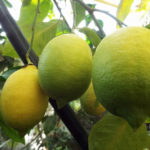
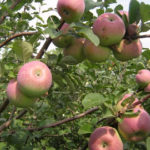



Good grade, Anniversary! Trees, in fact, grow very quickly. In the three years that the tree has been growing in my garden, it has reached the size of an adult apple tree, and has already begun to bear fruit - this year I have already collected the first three apples! They weigh about a little more than 100 grams, but this is quite enough for the first harvest. Our apples ripen a little earlier than indicated in the article, at the beginning of August, but the climate is also warmer and milder.
The apple tree should be formed during its development. It is better to do this in winter, or in late autumn, when frosts have already begun. In this case, it is necessary to cut off the central trunk and all excess internal branches, which will only be a burden for the tree. If you cut off young growth in a timely manner, then the fruits grow much larger. I have already cut my apple tree, let's see what the harvest will be next year.
Thank you for your feedback. We have this apple tree for the third year and now there are 3 apples hanging on it. The apple tree is not very big yet. Please tell me how much should the central trunk be cut? Thank.
Our family really liked the taste of the Yubilyar apples. Quite large, juicy and aromatic, the sourness in apples is only a slight hint. First harvest. Dwarf. Early August.